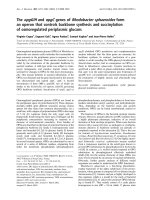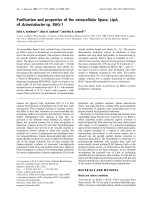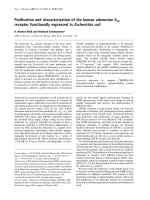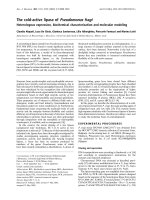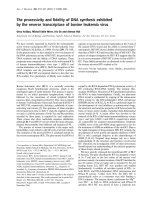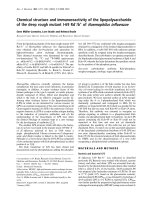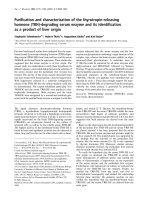Báo cáo y học: "The wisdom, and madness, of crowds" pot
Bạn đang xem bản rút gọn của tài liệu. Xem và tải ngay bản đầy đủ của tài liệu tại đây (56.21 KB, 3 trang )
Genome
BBiioollooggyy
2008,
99::
112
Comment
TThhee wwiissddoomm,, aanndd mmaaddnneessss,, ooff ccrroowwddss
Gregory A Petsko
Address: Rosenstiel Basic Medical Sciences Research Center, Brandeis University, Waltham, MA 02454-9110, USA.
Email:
Published: 1 December 2008
Genome
BBiioollooggyy
2008,
99::
112 (doi:10.1186/gb-2008-9-11-112)
The electronic version of this article is the complete one and can be
found online at />© 2008 BioMed Central Ltd
In reading the history of nations, we find that, like
individuals, they have their whims and their peculi-
arities; their seasons of excitement and recklessness,
when they care not what they do. We find that whole
communities suddenly fix their minds upon one
object, and go mad in its pursuit; that millions of
people become simultaneously impressed with one
delusion, and run after it, till their attention is
caught by some new folly more captivating than the
first…Money, again, has often been a cause of the
delusion of multitudes. Sober nations have all at
once become desperate gamblers, and risked almost
their existence upon the turn of a piece of paper…
Men, it has been well said, think in herds; it will be
seen that they go mad in herds, while they only
recover their senses slowly, and one by one.
Charles Mackay, L.L.D.
This quotation comes from a book first published in 1841. In
the 167 years since, it has never been out of print. Its author
was a Scottish poet, journalist and songwriter, yet many
have called it, after The Wealth of Nations by Adam Smith (a
fellow Scot - there really was something to the Enlighten-
ment, you know), the second greatest economics treatise
ever written.
The book is Extraordinary Popular Delusions and the
Madness of Crowds, by Charles Mackay. The quotation is
taken from its preface. If it sounds amazingly relevant to our
current economic crisis, it’s because it is. It may be the most
relevant book you will ever read.
Though published over time in two volumes, it is the first
volume, and in particular, the first three chapters, on what
Mackay called money mania and what we call economic
bubbles, that have given the book, which I shall refer to as
EPD&MOC for convenience, its well-deserved reputation.
The economist, and popular writer about personal finance,
Andrew Tobias, who contributed the Forward to the edition I
own, had this to say about it: “Once upon a time, there was
an emperor with no clothes. For the longest time no one
noticed. As you will read in this marvelous book, there have
been many naked emperors since. There will doubtless be
many more… As with any true classic, once it is read it is
hard to imagine not having known of it - and there is the
compulsion to recommend it to others.”
My favorite chapter is the third, on tulipomania. For those
unfamiliar with this psychological illness, which once
affected the entire country of Holland in the mid-seven-
teenth century, and spread to some people in other nations
of Europe as well, the term refers to a maniacal desire to
possess rare tulip bulbs. Fervor for collecting, and trading,
these essentially worthless botanical objects reached such a
peak, that at around 1635, the average price of a tulip bulb
exceeded its weight in gold, and a single rare bulb might
easily trade for more than $50,000 in today’s money. “A
trader at Harlaem,” writes Mackay, “was known to pay one-
half of his fortune for a single root - not with the design of
selling it again at a profit, but to keep in his own
conservatory for the admiration of his acquaintance… In
1634, the rage among the Dutch to possess them was so great
that the ordinary industry of the country was neglected, and
the population, even to its lowest dregs, embarked in the
tulip trade. As the mania increased, prices augmented, until,
in the year 1635, many persons were known to invest a
fortune of 100,000 florins in the purchase of forty roots.”
My favorite story from this bubble is so well-told by Mackay
that I will quote it rather than summarizing it:
“People who had been absent from Holland, and whose
chance it was to return when this folly was at its maximum,
were sometimes led into awkward dilemmas by their
ignorance… A wealthy merchant, who prided himself not a
little on his rare tulips, received upon one occasion a very
valuable consignment of merchandise from the Levant.
Intelligence of its arrival was brought him by a sailor, who
presented himself for that purpose at the counting-house,
among bales of goods of every description. The merchant, to
reward him for his news, munificently made him a present of
a fine red herring for his breakfast. The sailor had, it
appears, a great partiality for onions, and seeing a bulb very
like an onion lying upon the counter of this liberal trader,
and thinking it, no doubt, very much out of its place among
silks and velvets, he slyly seized an opportunity and slipped
it into his pocket, as a relish for his herring. He got clear off
with his prize, and proceeded to the quay to eat his
breakfast. Hardly was his back turned when the merchant
missed his valuable Semper Augustus, worth three thousand
florins, or about 280 pounds sterling. The whole establish-
ment was instantly in an uproar; search was everywhere
made for the precious root, but it was not to be found. Great
was the merchant’s distress of mind. The search was
renewed, but again without success. At last some one
thought of the sailor. The unhappy merchant sprang into the
street at the bare suggestion. His alarmed household
followed him. The sailor (a simple soul!) had not thought of
concealment. He was found quietly sitting on a coil of ropes,
masticating the last morsel of his “onion”. Little did he
dream that he had been eating a breakfast whose cost might
have regaled a whole ship’s crew for a twelve months; or, as
the plundered merchant himself expressed it, ‘might have
sumptuously feasted the Prince of Orange and the whole
court of the Stadtholder.’
By 1636, special markets for trading in tulip bulbs were
established on the floor of the Stock Exchanges in Amster-
dam and other towns. Many people grew suddenly rich, and
others, not wishing to be left out, began speculating madly
themselves. If this all sounds like the ‘dotcom’ bubble in the
stock market at the end of the 1990s, or the subprime
mortgage credit bubble of the past few years, it’s because the
same psychological factors that Mackay first dissected so
brilliantly in 1841, and that were at work in Holland in the
1630s, were behind those follies as well: greed, stupidity, the
herd instinct, and a reckless belief that the old rules of
economics were somehow repealed in this instance.
Of course tulipomania couldn’t last, and it didn’t. Mackay
again: “At last, however, the more prudent began to see that
this folly could not last for ever… It was seen that somebody
must lose fearfully in the end. As this conviction spread,
prices fell, and never rose again. Confidence was destroyed,
and a universal panic seized upon the dealers. A had agreed
to purchase ten Sempers Augustines from B, at four
thousand florins each, at six weeks after the signing of the
contract. B was ready with the flowers at the appointed time;
but the price had fallen to three or four hundred florins, and
A refused either to pay the difference or receive the tulips.
Defaulters were announced day after day in all the towns of
Holland. Hundreds who, a few months previously, had
begun to doubt that there was such a thing as poverty in the
land, suddenly found themselves the possessors of a few
bulbs, which nobody would buy, even though they offered
them at one quarter of the sums they had paid for them.
Many who, for a brief season, had emerged from the
humbler walks of life, were cast back into their original
obscurity. Substantial merchants were reduced almost to
beggary, and many a representative of a noble line saw the
fortunes of his house ruined beyond redemption.” Substitute
‘mortgage contracts’ or ‘derivatives’ for ‘bulbs’ in this
description, and you have a perfect accounting of the events
of the past few months of 2008. No wonder the book has
never been out of print.
Mackay wrote to warn people of the foolishness of the
collective mind. His warning seems to me to be particularly
relevant now, and not solely for economic reasons. The
central thesis of EPD&MOC is one we should at least
consider as we examine a new movement that has swept the
online publishing world and is beginning to creep into
genomics: the collective encyclopedia.
Everybody is probably familiar with the first, and best-
known, manifestation of this phenomenon: Wikipedia. The
name is a portmanteau of the words wiki (a technology for
creating collaborative websites) and encyclopedia. Wikipedia
is a multilingual encyclopedia project supported by the
nonprofit Wikimedia Foundation. Wikipedia’s 10 million
articles have been written collaboratively by volunteers
around the world, and almost all of its articles can be edited
by anyone who can access the Wikipedia website. Launched
in January 2001 by Jimmy Wales and Larry Sanger, it is
currently the largest and most popular general reference
work on the Internet.
The idea of a free encyclopedia encompassing all subjects,
written not by a panel of chosen experts but by teams of
people interested in the subjects and subsequently updated
and amended by anybody has been wildly popular but has
also attracted much criticism. Obviously, articles can, at least
initially, have severe biases and inconsistencies. The question
is whether in the end they get to the truth: does consensus
produce something that is not just readable - most of the
articles are pretty good in that regard - but reliable?
It turns out I have an entry in Wikipedia (don’t ask me who
contributed it; I certainly didn’t, and I haven’t edited it
either). If you do a Google search for my name, the
Wikipedia article will be the second entry in the resulting
list. Here’s an excerpt: “Gregory A Petsko is an American
biochemist and member of the National Academy of
Sciences. He is currently the Gyula and Katica Tauber
Professor of Biochemistry & Chemistry at Brandeis
University… Petsko is co-author with Dagmar Ringe of
Protein Structure and Function. He is also the author of a
monthly column in Genome Biology modeled after an
amusing column in Current Biology penned by Sydney
Genome
BBiioollooggyy
2008, Volume 9, Issue 11, Article 112 Petsko 112.2
Genome
BBiioollooggyy
2008,
99::
112
Brenner. Petsko is best known for using X-ray crystallo-
graphy to solve important problems in protein function,
including protein dynamics as a function of temperature and
problems in mechanistic enzymology.” All perfectly accurate,
though Sydney may blanch at the thought that he’s respon-
sible for this.
In my experience, Wikipedia is often inaccurate when it
comes to scientific facts, variable but occasionally quite good
when it comes to topics in history or politics, and absolutely
first-rate on any matter of popular culture. I suspect this
reflects the interest of the Internet-savvy population as a
whole, though I haven’t done any surveys to find out. I do
know that every teacher warns his or her students not to
trust it as an unconfirmed source of facts for term papers or
theses; it would appear that the wisdom of crowds is not
trustworthy without independent checking.
What does this have to do with genomics? Well, one of the
most highly accessed articles in recent issues of Genome
Biology was a piece by Barend Mons et al. entitled ‘Calling
on a million minds for community annotation in WikiProteins’
(Mons et al.: Genome Biol 2008, 9:R89). WikiProteins,
which is most conveniently accessed by entering keywords at
the WikiProfessional portal [iprofessional.
org/portal/], has pages for more than a million biomedical
concepts, derived from authorities such as the Unified
Medical Language System (UMLS), UniProtKB/Swiss-Prot,
IntAct and the Gene Ontology (GO). By adding information
to concepts in WikiProteins, scientists are invited to “expand
an evolving knowledge base with facts, connections to other
concepts, and reference information.” In other words, the
collective mind, scientifically speaking, is being called upon
to annotate gene functions, connections to diseases, and
other information relevant to functional and biomedical
genomics. Ideally, WikiProteins, which is still in the beta-
testing stage, should contain both reliable information from
experts and potential connections among data that haven’t
previously been noticed, or explored.
Here’s an example, called up by me by searching for ‘triose-
phosphate isomerase’, the name of an enzyme. I got a list of
triosephosphate isomerases from many different organisms.
Clicking on the one from Escherichia coli gave me the
following functional information: “isomerase activity
Definition: Catalysis of the geometric or structural changes
within one molecule. Isomerase is the systematic name for
any enzyme of EC class 5. [ISBN:0198506732 “Oxford
Dictionary of Biochemistry and Molecular Biology”].”
Perfectly accurate, though perhaps not ideally helpful. Doing
a similar search for ‘DJ-1’, a gene involved in Parkinson’s
disease, produced (after leaving out the hyphen): “Acts as a
positive regulator of androgen receptor-dependent trans-
cription. May function as a redox-sensitive chaperone and as
a sensor for oxidative stress. Prevents aggregation of SNCA.
Protects neurons against oxidative stress and cell death.
Plays a role in fertilization. Has no proteolytic activity. Has
cell-growth promoting activity and transforming activity.
Interacts with: with DAXX (accepted by Swiss-Prot); with
AR (accepted by Swiss-Prot).” Again, as far as I can tell,
accurate, and probably more helpful. There are a bunch of
links as well, only some of which I’ve explored, and the site
provides the opportunity not only to edit any entry but to
establish other links.
It is fairly well accepted that the functional and other anno-
tations in the commonly used genome and protein sequence
databases are at best accurate only about half the time (my
guess would be closer to 25%), so there’s real hope that this
community-based project might improve that appalling
figure. (It certainly would seem to have nowhere to go but
up.) It’s worth watching to see how WikiProteins does, and I
hope genome biologists will try it out, and contribute to it.
As an experiment in the wisdom of crowds, it’s fascinating.
But if you read Mackay (and I hope you all will; it just may
save you a lot of money some day), you will know to take
what’s in WikiProteins, or WikiAnything, with a good dose of
caution. Remember, ‘the community’ once thought tulip
bulbs were worth a fortune.
Genome
BBiioollooggyy
2008, Volume 9, Issue 11, Article 112 Petsko 112.3
Genome
BBiioollooggyy
2008,
99::
112


